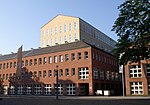Baumgarten-Bau

The Baumgarten-Bau (lit. 'Baumgarten Building') in Karlsruhe serves as the official seat of the Federal Constitutional Court. Built from 1965 to 1969 in the Botanical Garden of Schlossgarten, this building complex was originally composed of five pavilion-like structures with flat roofs, arranged around a long connecting corridor. Architect Paul Baumgarten created the original plans. The total floor area of the Baumgarten-Bau is approximately 16,000 square meters. The individual components of the building differ in height and have only a few stories. The glass and steel facade of the building gives it a plain and sober aesthetic and is attributed to the Modernist style. The Baumgarten-Bau became the official residence of the court in May 1969, replacing the Prinz-Max-Palais, which served as the official residence between 1951 and 1969 until it became inadequate for the growing need for space. The ensemble of buildings is designated as a cultural monument of special significance. From 2005 to 2007, an extension was added to the complex in the southwest, expanding it from five to six buildings. During extensive renovation work from 2011 to 2014, the Federal Constitutional Court temporarily relocated its official seat to the Oststadt district of Karlsruhe. In 2021, around 260 people were working in this building.
Excerpt from the Wikipedia article Baumgarten-Bau (License: CC BY-SA 3.0, Authors, Images).Baumgarten-Bau
Schlossbezirk, Karlsruhe Innenstadt-West
Geographical coordinates (GPS) Address Nearby Places Show on map
Geographical coordinates (GPS)
| Latitude | Longitude |
|---|---|
| N 49.012777777778 ° | E 8.4014722222222 ° |
Address
Bundesverfassungsgericht (BVerfG)
Schlossbezirk 3
76131 Karlsruhe, Innenstadt-West
Baden-Württemberg, Germany
Open on Google Maps











